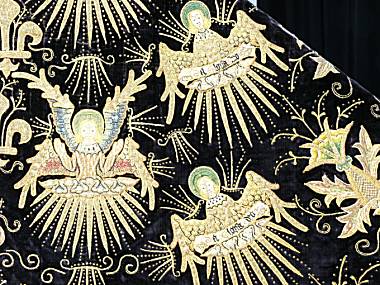| |
Winged beings
Almost all the high cultures know flying messengers as
mediators between the world of gods or spirits and the
earth. Thanks to their wings, they can easily move
between the here and now and the beyond. Wings mean
speed, the elevation of mind and soul, the motion of
everything earthly towards celestial life.
The Egyptians bestowed wings on a variety of godheads,
but also on the uraeus snake, the cobra. The Hebrew saraph
means as much as fiery snake, dragonlike creature or
"the burning one". In the Old Testament, Isaiah
described the seraphim as having six wings. As the snake
has had negative connotations in Christian tradition ever
since Adam and Eve were expelled from Paradise, the
seraphim have had human form.
The winged messengers of the Greek gods, called angelos,
had a lasting effect on the Christian view of angels.
The Christian view of angels
Angels are among the most popular religious motifs. Both
Christian and Islamic angels have their roots in the
Jewish religion. The Bible texts only describe cherubim
and seraphim as winged. All the other angels are light
beings and appear in human form. During the first four
centuries A.D., angels were depicted as serious, wingless
and clad in costumes of antiquity. From the fifth century
into the High Middle Ages, they had wings and wore
sumptuous liturgical robes. Their facial expressions now
conveyed joy. In the Renaissance, their wings were
majestic versions of goose and swan wings. In the Baroque
period, even the rustling of their wings seemed to be
audible. From the mid-15th century, angels' garments have
consisted of long, light-coloured and precious textiles.
The Christian view of angels: hosts and hierarchies
The angels of the Old Testament are helpful rescuers
but can also appear as avenging angels. With their
rebellion against God, they provoke the division of the
universe into good and evil.
As Lord of Sabaoth, God rules the heavenly hosts. In
early Christendom, this notion and the various types of
angels resulted in a complex hierarchical system:
distinctions were made between seraphim, cherubim and
thrones, between dominions, virtues and powers, and
between principalities, archangels and angels.
The Christian view of angels: Mary and the angel
A particularly intensive encounter with an angel is that
between Mary and the Archangel Gabriel. This encounter
has been depicted countless times in Christian art.
Frequent motifs of the veneration of the Virgin Mary are
also the Assumption and the Mother of God as Heavenly
Queen.
The Christian view of angels: Christ and angels
In Christian art, Jesus is accompanied by angels from his
birth to his resurrection. The angels who mourn the
crucified Christ in despair bear witness to the fact that
as angels, they know more than human beings, but are not
omniscient.
The Christian view of angels: saints and angels
Angels provide saints with help and support in their
trials and tribulations. It is from this role of
assistance that the guardian angels are derived. The
greatest influence on the idea of the guardian angel was
exerted by the legend of Tobias, whose faithful
travelling companion was the Archangel Raphael.
There is a close connection between the idea of the
guardian angel and the angels in heraldry. Coats of arms
of families and countries are often held by angels.
Chubby-cheeked cherubs
The special mediators of Antiquity are the winged
Erotes and Amores, who accompanied the goddesses of love
with bows and arrows. The Renaissance turned these into
putti. In the Baroque and Rococo eras, they were
transmuted into playful, cheerful and chubby-cheeked
cherubs. In the 19th and 20th centuries, they remained
the putti armed with bows and arrows but were also
extremely popular as little angels consisting only of
head and wings.
Ursula Karbacher, Curator, Textile Museum
Literature:
Flügelschlag : Engel im Film. – Berlin:
Filmmuseum, 2003
Freuler, G.; Euw, A. von. – Engel in der Schweiz und
überall. – Vevey, 2002
Früh, Margrit. – Aus der Welt der Engel. –
Frauenfeld: Hist. Museum Kt. TG, 1996
Godwin, Malcolm. – Engel : Eine bedrohte Art. –
5th ed. - Frankfurt a. M., 1995
Keel, O.; Staubli, T. – Im Schatten Deiner Flügel.
– Fribourg, 2001
Knapp, Gottfried. – Engel : Eine himmlische
Komödie. – Munich, 1999
Schoch, John. – Engel. – Zurich: Credit Suisse,
1999
|
